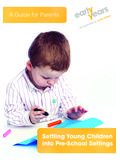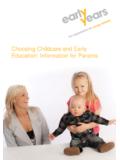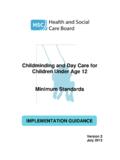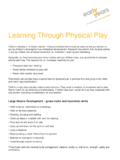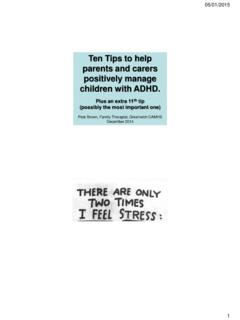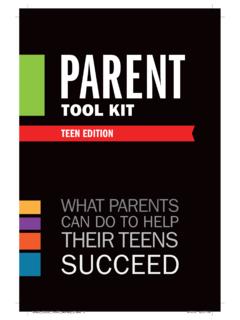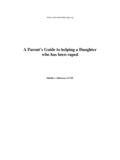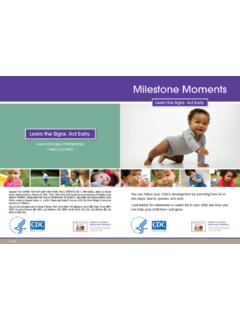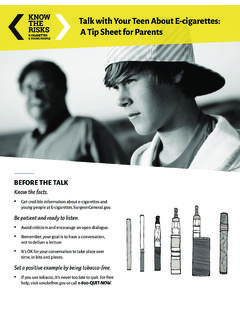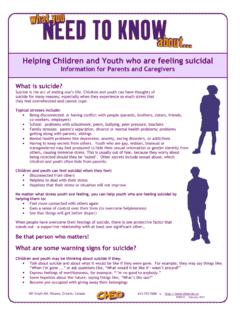Transcription of maths through play - Early Years
1 play is the natural way in which children learn. It is the process through which children explore, investigate, recreate and come to understand their world. play is an activity in which everything that a child knows and can do is practised or used to make sense of what is of the AdultThe quality of children s play is greatly infl uenced by the adults around them. Adults can provide materials and encouragement and open the door to new activities and learning. play cannot be directed by adults. An adult can support, enhance or extend play , but the moment they interfere or dictate its progress then it ceases to be through PlayTo many adults, the words maths and play have absolutely nothing to do with each other. For many of us, maths was a torture, something we had to do, and something we didn t understand and couldn t do. play on the other hand was something we children are learning maths all the time through a wide variety of play experiences.
2 From the time they are born, babies are surrounded by sense impressions. Shapes in particular are of immediate importance: babies react instinctively to the arrangement of shapes which make up the human the home, in parent and toddler groups, and pre-school settings, children have many opportunities to enjoy and learn maths through play . play is an effective vehicle for fostering Mathematical concepts and developing positive attitudes to Adults in the pre-school setting should seek to extend informally the mathematical experiences the children have already had in their home environment. (Curricular Guidance for Pre-school Education) (back page) maths in the HomeMaths is everywhere in the home. With the support of parents, children can grasp many mathematical concepts through their through PlayChildren will begin to: know and understand Early maths language of measurement, shapes, spaces, positions, Early numbers, order and patterns know the sequence of numbers begin to understand positional words, in, on, outside show an awareness of time be aware of shapes in their environment be aware of 1-to-1 correspondence acquire new vocabulary learn number rhymes and songs, one, two, buckle my shoe etc.
3 Be aware of conservationWhen we say a child knows her numbers what we often mean is that she can recite the names of numbers in ascending order. This is quite useful to be able to do, but it means very little in itself. Children need to come to know what the number system really means. They can be helped to do this through of the fi rst things they have to learn is about conservation that 3 is always 3 no matter how it is arranged or presented, whether it is the number 3, the letters for three, 3 bricks, 3 buttons on a coat or 3 Billy Goats a child can understand numbers for things that can be seen 3 miles, 3 Years old s/he needs real objects which can be seen and handled with a chance to check that the count is right each children have many mathematical experiences in their home environment. For example: they learn about money as they go shopping with parents become aware of numbers as they count the stairs to bed start to understand the concept of time as they become familiar with the routine of their day wash, dress, breakfast child s daily life offers many practical opportunities to learn about number, shape, space, sorting and matching.
4 For instance: setting places at the table a cup for me, a cup for you playing with water steering the pram helping to sort the washing, matching socks, big shirt / small shirt tidying up putting similar items together matching lids to saucepansHere are a few ways in which you can use play to learn mathematical concepts. Sand and Water Using sand can develop mathematical concepts and language, heavy, light, empty, full, big, little Conservation how much will it hold Make shapes and patterns Provide boxes and materials of different shapes and sizes to compare weight and quantity Look at the differences between wet and dry as a means of looking at weightsLanguage You can help to promote mathematical language such as heavy, light, empty, full, long, short, big, small in relevant contexts Look at your home environment to develop language, especially positional words small object in front of big object, behind, in, onDoughThe use of dough can help to develop a mathematical understanding for pre-school children.
5 Develops mathematical language short, long, fat, thin Make shapes of different dimensions fl at shapes, 3-d shapes Create opportunities to compare things that fl oat with things that do notImaginative play Simple activities like letting your child set the table for dinner can help develop counting skills, getting out three pieces of cutlery. Involve your child with household activities. After washing, allow your child to sort clothes into different colours, or different types of clothes, t-shirts and socks. This will help to develop a child s knowledge of shapes and and RhymesEnjoy stories and rhymes with your child that has a mathematical element, One-two, Buckle my Shoe , This can also help to develop literacy skills by showing your child that the print reads from left to your child count out items in the books how many animals are on the page, how many items are rhymes can also help develop your Childs awareness of sequenceingPhysical play Develop fi ne motor skills through physical activity, Sorting out a jigsaw, Threading beads Block play or playing with toy cars can help to develop sequencing by encouraging your child to sequence according to size, colour, use ( bike, car, lorry) Playing with different sized blocks can help to develop an understanding of weight and dimensions.
6 Tidying toys away allows children to sort into different sizes and colours. It can also develop mathematical language fi rst, second, third, how many are blue, which is largest / planting seeds you can help to develop your child s understanding of time and the life cycle of as the plants grow and even measure your plant develop language such as your child about the different seasons and plant different items at different times of the year to compare colours, fl owers, smells. There are many opportunities for learning maths through play . For more ideas on Learning through play , get a copy of I Want To play , a publication full of practical ideas to use at home with young children, available at Early Years , 6c Wildfl ower Way, Apollo Road, Belfast, BT12 6TA, Tel: 028 9066 2825.
